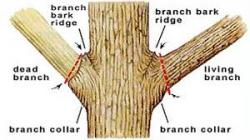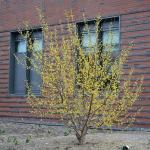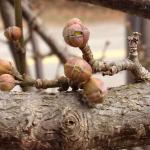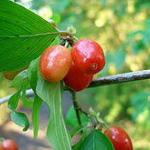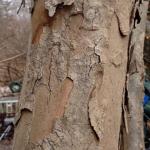A monthly e-newsletter from UMass Extension, published March to October, for home gardeners.
To read the articles in each section of the newsletter, click on the section headings below to expand the content:
Tips of the Month
March is the Month to…..
-
Start thinking about sowing seeds indoors. Make sure you have all your supplies ready including soilless media, pots, and lights. A good seed starting mix should be sterilized, contain little or no fertilize, and should be of a fine consistency - typically, a mixture of fine peat and vermiculite. Use small containers to start seeds and transplant into larger containers as they grow. When reusing containers, wash them to remove debris and soil and then sterilize by soaking in 10% bleach (bleach, once diluted, is only effective for about a day). Fluorescent lights or LED’s work well for starting seedlings. When choosing LED’s, make sure they provide light in the blue and red spectrums, which are suitable for plant growth. When choosing fluorescent lights, use “grow bulbs” or cool white lights; these have the suitable light spectrums for plant growth.
-
Start some cool season vegetable transplants like brassicas - cabbage, broccoli, and cauliflower. Germinate the seeds under warm conditions but grow the plants at cooler temperatures, 55-65 degrees F, if possible. Early March is still suitable for starting onions from seed and other cool season crops like swiss chard. By the end of March, you may want to start thinking about starting slower warm season transplants like peppers.
-
Start annual flowers like cleome, cosmos, four o’clocks and marigolds from seed for transplanting in May.
-
Prune trees. The lack of leaves makes it easy to observe a tree’s structure and make structural pruning decisions. Remember that the most important years for pruning a tree is from years 2-10 to develop a good structure. For spring blooming trees and shrubs, you may want to wait until after bloom to prune for maximum floral display.
-
Prune shrubs. When pruning shrubs that create multiple stems from the ground like blueberry, spirea, viburnum, winterberry, and elderberry, start by removing one or two of the oldest stems. This will help keep the shrubs healthy and promote young vigorous growth to emerge from the base of the plant.
-
Pay more attention to your houseplants. The intensity and length of days starts to increase rapidly in March. Houseplants that receive more natural light will likely need more attention to watering and fertilizing to keep them healthy. Consider giving your houseplants a shower (literally) - dust can accumulate on the leaves during the winter when windows and doors remain shut. Put them in the shower and give them a good soaking.
-
Avoid compacting soil. With the abundant precipitation during the winter and early spring, soils are often extremely wet and susceptible to compaction. Compaction can occur when heavy equipment like trucks and tractors or even from foot traffic and when wheelbarrows are moved over wet soils. In some instances, it may be possible to utilize sheets of plywood to help distribute the weight if you know you will be moving heavy materials over wet soil.
-
Beware of ticks. Black-legged ticks (deer ticks) adults will be active any time the temperatures are above freezing. Keep yourself protected by wearing permethrin treated clothing and doing vigilant tick checks when done working outside for the day.
Russ Norton, Cape Cod Cooperative Extension
Timely Topics
March is for Pruning
March is usually not a gardener’s favorite month, as there is not much in bloom and it may be a cold, gray, month. However, on those sunny days, it is great to be able to go out in the garden and see what may be coming up and of course begin spring cleanup and pruning.
Pruning has been called “an art and a science”; and maybe there is some truth to that saying. There is a bit of an art to shaping and forming plants and a science as to where and how to make the cuts. Many people are timid about pruning, but it really isn’t that difficult once you understand what needs to be done, when to do it and have the right tools.
March is an opportune time, before new growth begins, to prune many trees and shrubs, especially fruit trees, blueberries, raspberries and grapes. At this time of year, it is easy to see branches, limbs and trunks and assess any damage or breakage from winter storms and winds and remove any broken or damaged branches. It is important to make a correct cut when pruning branches. Years ago, the thinking then was to make a “flush cut” or cut the branch as close to, or “flush”, with the bark as possible and cover the cut, usually with an asphalt-based wound dressing or sealant. All that changed over 30 years ago when the late Dr. Alex Shigo proved that flush cuts actually encouraged decay and that sealants had no beneficial effect to slowing decay. Through years of research, Dr. Shigo went on develop a new concept of pruning that is still used today.
For these guidelines, diagrams of proper pruning cuts, and more info on Dr. Shigo’s work, go to:
http://www.thepruningschool.com/Articles/shigo.htm
If you think a large tree is dead, or it might be hazard tree, or if it is a large tree too close to a structure, then you might consider contacting a licensed and insured arborist, preferably a Massachusetts Certified Arborist (MCA), who could safely remove the tree or reduce its’ size correctly. More than one estimate is usually recommended, along with proof of insurance. To find a MCA in your area, go to http://massarbor.org
Besides pruning to remove dead, broken, damaged or diseased wood, we also prune to manage and maintain size and shape, to rejuvenate an overgrown plant, and to encourage flowers and fruit.
Usually, it is recommended to prune a plant according to the natural shape or form of the plant, and avoid shearing, unless the plants are being trained for a hedge, topiary or espalier. Some plants do not do well when sheared into the shape of a square, ball, lollipop, etc.
When pruning hedges, regardless of what type of plants are used, the important fact to remember is to shape the hedge so that the base, or bottom, of the hedge is wider than the top, allowing sunlight to reach all parts of the plant. Unfortunately, many people prune hedges the opposite way, so that the top of the hedge is wider than the base, thereby blocking or reducing the amount sunlight to the interior of the hedge. For more details on pruning hedges, go to https://aggie-horticulture.tamu.edu/newsletters/hortupdate/hortupdate_archives/2001/mar01/art5mar.html
It pays to invest in good, quality tools to prune - tools that will be reliable, make good cuts and not break easily; tools that will work with you to get the job done. Good quality hand pruners, lopping shears, a pole pruner, a hand saw and perhaps a pole saw are some of the tools needed to prune, depending on the job. It is important to keep the blades sharp and clean when pruning; purchasing a sharpening tool will enable you to sharpen the blades as they become dull.
Most non-ornamental flowering deciduous tree and shrubs, along with hemlock, Chamaecyparis, Arborvitae, Juniper, Ilex (holly), Taxus (yew) may be pruned in March, if needed.
March is not the best time to prune spring flowering plants like: lilac, Daphne, rhododendron, Mt. Laurel, mock orange, Deutzia, Wiegela, Hydrangea macrophylla, Pieris, azaleas, dogwoods, Fothergilla, Viburnum, Forsythia, etc. Pruning now will remove the flowers buds that were formed last year and the plants will not bloom this spring. The best time to prune spring flowering trees and shrubs is immediately after they have bloomed, before they set buds for next year. Pruning those plants in late summer, fall, or winter, before bloom, will usually result in few or no flowers.
Unlike ornamental trees and shrubs which may need occasional pruning, plants that bear fruit (apple, plum, peach, pear, blueberry, grape and raspberries require pruning on an annual basis, which means they need to be pruned every year. Pruning every year may increase yield by allowing more light into the canopy and also helps to increase air flow which may help reduce disease.
Pruning fruit trees, especially apples, can be a bit intimidating and some guidance from a class, video, or fact sheet can be very helpful. UMass sponsors a series of seminars for the home gardener that may be helpful in its Mass Aggie Seminars. The 2018 selections can be found at http://ag.umass.edu/fruit/news-events/mass-aggie-seminars
If that is not an option for you, the following videos and fact sheets may be of help with pruning and growing backyard fruit.
Videos and/or fact sheets on pruning:
Apple trees:
Dr. Wes Autio, UMass Extension:
http://www.newenglandgrows.org/pdfs/ho_AutioHandout14Thurs.pdf
Connie Kratzke, Kahnke Brothers Tree Farm, Plato, MN
https://www.youtube.com/watch?v=foRtMmBmJk4
Peach Trees:
Dr. Wes Autio, UMass Extension
https://www.youtube.com/watch?v=OBrwFTYrlc4
Blueberries:
University of Maine Extension:
https://extension.umaine.edu/highmoor/videos/blueberry-bush-pruning
https://extension.umaine.edu/publications/2253e/
Grapes:
University of Maine Extension:
https://www.youtube.com/watch?v=ApcQOp-IEgk
Pennsylvania State University Extension:
https://extension.psu.edu/pruning-grapes-in-home-fruit-plantings
Raspberries:
University of Maine Extension:
https://www.youtube.com/watch?v=pOzo4s9Z9jE
https://extension.umaine.edu/publications/2066e
Pruning plants, correctly, benefits plants. Do not be afraid to make that first cut, as most plants are very forgiving and will usually outgrow most ‘mistakes’.
Last but not least, be careful when pruning, especially when using ladders and chain saws. See UMass Extension’s Pruning and Ladder Safety: https://ag.umass.edu/home-lawn-garden/fact-sheets/pruning-ladder-safety
Deborah C. Swanson, Horticulturist
2018 Workshops for Home Gardeners
- March 3 Edible Landscaping with Fruit, Amherst
- March 24 Home Orchard Pruning - a Hands-on Workshop, Great Barrington
- March 31 Pruning Blueberries - a Hands-on Workshop, Bolton
- April 7 Home Orchard Establishment & Basics - a Hands-on Workshop, Great Barrington
- April 7 Home Orchard Pest Management - a Hands-on Workshop, Great Barrington
- April 14 Native Pollinator Biology and Conservation, Amherst
For more details, including how to register, go to http://ag.umass.edu/fruit/news-events/mass-aggie-seminars
News for Gardeners
UMass Garden Calendar Photo Contest
LAST CALL! The deadline for submitting pictures to photo contest for the 2019 UMass Extension Garden Calendar is April 1, 2018. Images must be oriented horizontally and be large enough to provide a high quality print for the calendar. Submission details are at https://ag.umass.edu/landscape/publications-resources/garden-calendar/garden-calendar-photo-contest.
Defoliating Caterpillars: Outlook for 2018
Winter Moth
With the unseasonably warm temperatures on February 20th and 21st, anyone in the habit of tracking growing degree days (GDD’s) may have, in addition to abandoning the winter jacket, felt the need to do some calculating. UMass Extension’s Landscape Message will resume for 2018 shortly, reporting growing degree days accumulations, and the annual winter moth (Operophtera brumata) egg-hatch monitoring will begin.
Preferred hosts of winter moth include the leaves of oak, maple, and apple in addition to other deciduous plants including, but not limited to, cherry, basswood, ash, elm, crabapple, and blueberry. Winter moth caterpillars may also drop or ‘balloon’ onto nearby plants like roses, herbaceous perennials, annuals, etc. that may be found near or beneath infested trees. Partial defoliation of hosts can be the norm for this species. Damage to blueberry and apple crops is especially severe as the reproductive parts of their flowers responsible for fruit can be destroyed by this insect before buds open fully.
Winter moths overwinter in the egg stage, hidden in cracks and crevices of host plant bark or beneath lichen. Eggs are tiny and very difficult to see. Egg hatch has historically occurred any time between late March to early-mid April, depending upon the year and the location. For those of you tracking growing degree days, egg hatch in Massachusetts occurs when 20–50 GDD’s (base 50º F) have accumulated. The Elkinton Lab at UMass uses a base 40ºF when completing growing degree day calculations for this insect and suggests that hatch occurs between 177 and 243 GDD (base 40°F).
What can we expect from the winter moth population in eastern Massachusetts this year? Hopefully it will continue to be the lowest it has been in over a decade, as was seen in the 2017 season. Anyone with high-value crops that could be impacted by this pest should continue their normal monitoring activities to aid in decision-making regarding management of winter moth. Homeowners who experienced record-low winter moth populations last season may continue to enjoy such conditions again in 2018. For more information about the recent declines in the winter moth population, please see the February issue of Hort Notes, under Trouble Maker of the Month, at https://ag.umass.edu/landscape/newsletters/hort-notes/hort-notes-2018-vol-292 .
Gypsy Moth
What can we expect from gypsy moth (Lymantria dispar) following the 2017 growing season, during which time caterpillars of this species defoliated over 923,000 acres across Massachusetts? (For a map of the 2017 defoliation due to gypsy moth, go to

https://www.mass.gov/guides/gypsy-moth-in-massachusetts.) This may depend upon how many overwintering egg masses laid by female moths in 2017 are visible near you. White oak is a preferred host for the caterpillar stage of this insect, but the host list for gypsy moth is very large, including the leaves of many deciduous trees and shrubs such as maple, birch, poplar, willow, apple, hawthorn, and many others. In years where heavy populations exist, such as in 2017, eastern white pine and spruce needles are also fed upon.
The outlook for 2018 is undoubtedly much better than it would have been if the gypsy moth caterpillar-killing fungus, Entomophaga maimaiga, did not catch up with the caterpillars in late June of 2017. At that time, many dead caterpillars were seen hanging from tree trunks and branches, killed by the fungus, which was aided by the wet spring weather earlier in the year. Need a reminder of what that looked like? Go to https://ag.umass.edu/landscape/news/gypsy-moth-caterpillars-dying-across-massachusetts .
Despite the fungal outbreak that swept through the caterpillar population, some lucky caterpillars survived to pupation and emerged as adult moths. Following mating, females laid the egg masses that are currently overwintering and are expected to hatch roughly between 90-100 GDD’s (base 50ºF) or approximately the first week in May in Massachusetts. Timing may vary depending upon local temperatures.
While it is very difficult to predict how much defoliation Massachusetts will see in 2018 due to gypsy moth caterpillar feeding, we can be certain that in areas where many egg masses are currently seen overwintering, pockets of defoliation could still occur across the state this year. Thanks to the gypsy moth caterpillar-killing fungus, the population should be on the decline, but we cannot expect the caterpillars to disappear completely from Massachusetts landscapes this season.
Looking for a MA Licensed Professional?
Professionals working in Massachusetts who apply pesticides, including insecticides for the management of winter moth and gypsy moth, are required to be licensed or certified with the Massachusetts Department of Agricultural Resources (MDAR). This includes making applications of general use products as well as restricted use products. General and restricted use products are defined here: https://www.mass.gov/files/documents/2017/10/30/333cmr10.pdf . A list of MA State Restricted Use Products can be found here: https://www.mass.gov/pesticide-product-registration .
If you have questions about pesticide regulations in Massachusetts, visit: https://www.mass.gov/service-details/pesticide-regulations-in-massachusetts . A Consumer Information Bulletin for Tree/Shrub Care is also available at https://www.mass.gov/files/documents/2016/08/rg/cib-tree.pdf .
Need to confirm that a professional is licensed or certified with MDAR to apply pesticides in Massachusetts? Visit the new searchable web page available at https://eeaonline.eea.state.ma.us/EEA/PublicApp/ .
Tawny Simisky, UMass Extension Entomologist
Trouble Maker of the Month
Botryosphaeria Canker
With spring on the horizon, it’s a good time to start thinking about stem and branch cankering fungi. Specifically, it’s a good time to scout for and prune dead stems and branches on conifers and hardwoods before both the pathogen and host break dormancy for the season. In general, stem cankering fungi like Botryosphaeria behave as opportunistic pathogens that attack weakened and stressed hosts. Many landscape ornamental trees and shrubs serve as hosts in the region, which include: apple/crabapple, cherry, dogwood, honeylocust, elm, oak, ash, holly/inkberry, maple, pine, spruce, hemlock and rhododendron/azalea. Trees with thin bark and dense canopies are particularly prone to attack (e.g. Japanese maple and columnar holly).
Drought stress, transplant shock, excessive pruning and insect feeding all serve to predispose trees and shrubs to attack from stem and branch cankering fungi. Many otherwise healthy trees and shrubs often harbor very low populations of stem cankering fungi in their canopies. As stresses mount, cankering pathogens can increase in abundance throughout the canopy, progressively causing more damage. Dormant season pruning is a good way to eliminate these pathogens from the canopy to reduce inoculum and help protect succulent plant parts produced in the spring from becoming attacked.
Scout for stems and branches that appear desiccated, have sunken lesions that may be stained by sap or resin, open cankers, rough callus tissue, cracking and splitting bark and a lack of live buds at the shoot tips. Signs of stem cankering fungi like Botryosphaeria include black-colored pads of fungal tissue rupturing through the bark of dead stems and branches. They are most often observed on small diameter stems as opposed to larger branches. With careful scouting, they can often be readily observed in the field.
For more information see the Botryosphaeria canker fact sheet at http://ag.umass.edu/landscape/fact-sheets/botryosphaeria-canker
Nicholas J. Brazee, UMass Extension Plant Pathologist
Plant of the Month
Cornus mas, Cornelian cherry dogwood
March is one of those grey wintery months when not much is happening, color-wise, in the garden. One plant that does bring bright color to the drab March landscape is Cornus mas or Cornelian cherry dogwood.
Cornus mas is a small (20-25 feet high; 15-20 feet wide) tree, or a large multi-stemmed shrub, native to central and southern Europe and western Asia, and usually begins to flower in March, persisting for several weeks.
The flowers are bright yellow, providing welcoming color when few plants are in bloom. The individual flowers (1/16 inch diameter) are held in ¾ inch wide, rounded umbels, or small clusters, and appear before the foliage, making them noticeable in the winter – early spring landscape. Bees, and other pollinators, are attracted to the flowers and grateful for such an early pollen and nectar source. The glossy dark green leaves (2-4 inches long; ¾ - ½ inch wide) appear after the flowers. Autumn color may be a mix of green and burgundy foliage in the fall, but fall color is usually not significant.
The fruit of Cornelian cherry dogwood is a bright red, shiny elongated drupe (5/8 inch long; ½ inch wide), similar in shape to an olive. The fruits are produced usually in mid to late summer and are edible. Birds enjoy them and some people do too, although they are sour and not very palatable. The fruits have been used to make preserves, syrups, etc.
The grey-brown-tan, exfoliating bark on older specimens can provide winter interest along with the small, ball-shaped buds. Cornelian cherry dogwood may be used in a number of ways in landscape settings, including as a specimen tree or shrub or in combination with other plants a mixed border. There are several cultivars available, including Cornus mas ‘Aurea’, which displays yellow foliage, and ‘Golden Glory’, a dense flowering cultivar with an upright form.
Cornus mas is hardy to zone 4, has no significant insect or disease problems and prefers a site with full sun to partial shade. It is fairly soil adaptable but prefers a moisture retentive, organic, well-drained soil.
Cornus mas is a valued plant not only for its’ early spring bloom, but also for its low maintenance, multi-seasonal interest, winter hardiness and attractiveness to birds and pollinators. It is the recipient of the Cary Award designation from Tower Hill Botanical Garden, as well as The Gold Medal award from the Pennsylvania Horticultural Society.
Deborah C. Swanson, Horticulturist
Additional Resources
Landscape Message - for detailed timely reports on growing conditions and pest activity
Home Lawn and Garden Resources
Find us on Facebook! www.facebook.com/UMassExtLandscape/
Follow us on Twitter for daily gardening tips and sunrise/sunset times. twitter.com/UMassGardenClip
Diagnostic Services
The UMass Extension Plant Diagnostic Lab provides, for a fee, woody plant and turf disease analysis, woody plant and turf insect identification, turfgrass identification, weed identification, and offers a report of pest management strategies that are research based, economically sound and environmentally appropriate for the situation. Accurate diagnosis for a turf or landscape problem can often eliminate or reduce the need for pesticide use. Sampling procedures, detailed submission instructions and a list of fees.
The UMass Soil and Plant Nutrient Testing Laboratory at the University of Massachusetts Amherst provides test results and recommendations that lead to the wise and economical use of soils and soil amendments. The Routine Soil Analysis fits the needs of most home gardeners. Sampling procedures plus the different tests offered and a list of fees.
Spread the Word!
Share this newsletter with a friend! New readers can subscribe to our Home Gardener E-Mail List.
